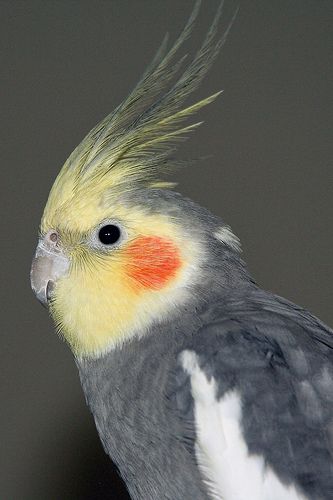
The cockatiel is flying out of the spotlight as our Animal of the Month to make way for a new featured creature for November. We hope you enjoyed our tweets about these popular birds on our Twitter account @ExoticPetVets. But in case you missed them, here is a summary of the cockatiel facts we highlighted throughout October. Did you know?:
- The cockatiel (Nymphicus hollandicus) is likely the second-most popular pet bird behind the budgerigar, or budgie.
- Cockatiels are gentle, love to play and are well-suited to be in a family that includes children.
- Cockatiels are generally quiet, but are great whistlers and have a limited ability to mimic human speech.
- Cockatiels are from Australia, but they’re commonly known as “quarrion” in their country of origin.
- Cockatiels are also known as “weero” in Western Australia and have other names depending on the local native language.
- Cockatiels are considered to be nomadic and travel in small flocks or pairs.
- Cockatiels are one of more than 370 species of parrot.
- Cockatiels create a lot of dust because of the white powder-down feathers that help insulate them.
- The tips of these powder-down feathers crumble and create dust when a cockatiel preens.
- The dust from a cockatiel’s feathers can be a problem for people with asthma or other respiratory problems.
- Cockatiels love to chew so, in captivity, they need bird-safe toys so they don’t chew destructively around the house.
- Ensure untreated and non-toxic pieces of wood or branches are available for your pet cockatiel to chew.
- Pet cockatiels should be exposed to various people, pets and experiences (i.e. car trips) to help them be well-adjusted.
- Cockatiels in captivity need larger cages to accommodate their long elegant tails.
- A cage for a cockatiel in captivity should be a minimum of 2 ft x 2 ft x 3 ft long (60 cm x 60 cm x 90 cm).
- Cockatiels are naturally grey birds with yellow faces and an orange cheek patch with white on front part of wing.
- Cockatiels are famous for the distinctive crests on their heads. These crests indicate the birds’ emotional state.
- A cockatiel’s crest is flat and close to the head when she is angry or defensive.
- When surprised or excited, the cockatiel’s crest is vertical. The crest is naturally sloped when she is relaxed.
- Cockatiels come in a wide variety of colour mutations due to selective breeding.
- Colour mutations for cockatiels in captivity include Cinnamon, pied, pearled, white-faced, albino and Lutino.

